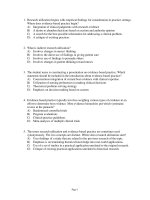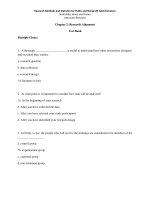Test bank nursing research methods and critical appraisal for evidenced based practice 8th download
Bạn đang xem bản rút gọn của tài liệu. Xem và tải ngay bản đầy đủ của tài liệu tại đây (625.38 KB, 6 trang )
Test Bank Nursing research methods and critical appraisal for
evidenced based practice 8th
Chapter 04: Theoretical Frameworks for Research
Test Bank
MULTIPLE CHOICE
1. Which phrase correctly defines a theory?
a. The operational definition of the study’s conceptual framework
b. The assumptions and beliefs of the worldview of the researcher
c. A set of interrelated concepts that provides a systematic view of a phenomenon
d. A researcher’s best guess of the direction of the relationship between variables
ANS: C
A
B
C
D
Feedback
The operational definition of the study specifies how the findings will be
measured.
The assumptions and beliefs of the worldview of the researcher is the
paradigm or philosophical framework of the researcher.
A theory is a set of interrelated concepts that provides a systematic view of a
phenomenon.
The researcher’s best guess of the direction of the relationship between variables
is a hypothesis.
DIF: Cognitive Level: Remembering (Knowledge)
REF: Page 77
2. In which way are theory and practice interrelated for the hospital-based nurse researcher?
a. Practice is the operational definition of theory.
b. Practice provides the opportunity to test theory.
c. Theory provides the evidence on which practice is based.
d. Theory generates questions that are used to refine practice.
ANS: B
A
B
C
D
Feedback
Theory is abstract and is not operationally defined as practice.
Practice environments provide settings in which to test theory.
Theory is a guide for research, and research provides evidence for practice.
Research helps to refine questions related to practice.
DIF: Cognitive Level: Understanding (Comprehension)
REF: Page 80-81
3. Which nursing theory is classified as a Grand Nursing Theory?
a. Polk’s Theory of Resilience
b. Mishel’s Uncertainty in Illness Theory
c. Orem’s Self-Care Deficit Nursing Theory
d. Im’s Theory of Caucasians’ Cancer Pain Experience
ANS: C
A
B
C
D
Feedback
Polk’s Theory of Resilience is considered a Middle-Range Nursing Theory
because it contains a limited number of concepts and is focused on a limited
aspect of reality.
Michel’s Uncertainty in Illness Theory is considered a Middle-Range Nursing
Theory for the reasons described for option A.
Orem’s theory is a Grand Nursing Theory since it is an all-inclusive conceptual
structure that includes views on person, health, and environment.
Im’s Theory of Caucasians’ Cancer Pain Experience is considered a SituationSpecific Nursing Theory because it is narrow in scope and explains a small
aspect of the phenomena of interest to nurses.
DIF: Cognitive Level: Understanding (Comprehension)
REF: Page 81
4. Situation-specific nursing theories are becoming more popular in nursing research for
which of these reasons?
a. Increased emphasis on evidence-based practice
b. Increased need for broad and generalizable models to explain phenomena
c. Decreased resources for funding of grand theory development
d. Decreased use of theories borrowed from other disciplines
ANS: A
A
B
C
D
Feedback
Situation-specific theories provide closer links between theory and practice,
which is important because of the increased demand for evidence-based practice.
At present, there is no increase in need for grand nursing theories that are
generalizable across populations, health, and environments.
Resources for funding grand theory development in nursing have always been
limited.
Nursing frequently borrows concepts, models, and theories from many other
disciplines.
DIF: Cognitive Level: Understanding (Comprehension)
REF: Page 82-83
5. A graphic or symbolic representation of a phenomenon not directly observable, which
allows the reader to visualize key constructs and their interrelationships, is called what?
a. A concept
b. A conceptual definition
c. An operational definition
d. A model
ANS: D
A
B
C
D
Feedback
A concept is an image or symbolic representation of an abstract idea that can
be concrete (e.g., weight) or abstract (e.g., hope).
A conceptual framework defines or explains the concept as it is rooted in
the theoretical literature.
The operational definition specifies how a concept will be measured.
A model is a graphic or symbolic representation of a phenomenon that allows a
reader to visualize the key concepts/constructs and their identified
interrelationships.
DIF: Cognitive Level: Remembering (Knowledge)
REF: Box 4-4
6. How is a model related to a concept or concepts?
a. A model tests conceptual theories.
b. A concept defines the purpose of a model.
c. Relationships between or among concepts are demonstrated in a model.
d. Concepts generate the theoretical basis for knowledge depicted in a model.
ANS: C
A
B
C
D
Feedback
A model does not test theories.
A concept does not define a model.
A model allows the reader to visualize the key concepts and their identified
interrelationships.
Concepts do not generate theory for knowledge depicted in a model.
DIF: Cognitive Level: Understanding (Comprehension)
REF: Page 78-79
7. Pender’s health promotion model is an example of what type of theory?
a. Grand nursing theory
b. Middle-range nursing theory
c. Situation-specific nursing theory
d. Another discipline’s theory applied to nursing
ANS: B
A
B
C
Feedback
Pender’s health promotion model is not a grand nursing theory or all-inclusive
model to describe nursing as a whole.
Pender’s health promotion model is a middle-range nursing theory focused on a
limited aspect of reality.
Pender’s health promotion model is not a situation-specific theory or narrow in
scope, explaining a small aspect of a phenomenon.
D
Pender’s health promotion model is not a theory from another discipline applied
to nursing; it is a nursing model.
DIF: Cognitive Level: Understanding (Comprehension)
REF: Page 81-82
8. Which statement is an operational definition of a concept?
a. Death anxiety is an uncomfortable feeling on contemplation of one’s own death,
measured by Templar’s Death Anxiety Scale (Templar, 1986).
b. Pain is a pattern of responses to protect the organism from harm (Sternbach, 1979).
c. Maternal identity entails maternal cognitions and affect with regard to the
maternal-infant relational system (Walker and Montgomery, 1994).
d. Spirituality is a way of being or experiencing that comes about through an
awareness of a transcendent dimension and one’s identifiable values with regard
to self, other, nature, and whatever one considers to be ultimate (Elkins, 1988).
ANS: A
A
B
C
D
Feedback
An operational definition of death anxiety is provided because it states
how death anxiety will be measured.
This statement is a conceptual definition of pain.
This statement is a conceptual definition of maternal identity.
This statement is a conceptual definition of spirituality.
DIF: Cognitive Level: Understanding (Comprehension)
REF: Page 78-79
9. When reading a report of results of a nursing research study, the nurse notices that the
theoretical framework is drawn from a discipline other than nursing. When critiquing the
theoretical framework, the nurse should determine the answer to which of these questions?
a. Does the research have implications across disciplines?
b. Is the researcher a recognized leader in the discipline of nursing?
c. Does the author have special expertise or education in the discipline from
which the theoretical framework is derived?
d. Has the author clearly indicated the meaning of the theoretical framework to
the study and linked it to nursing?
ANS: D
A
B
C
D
Feedback
The author should cite the implications of the research for nursing.
The author of a research article need not be a recognized leader in nursing.
The author should have an understanding of the framework but does not need to
have expertise in the discipline from which it is derived.
The theoretical framework does not have to come from nursing but should
be linked to the practice of nursing.
DIF: Cognitive Level: Understanding (Comprehension)
REF: Page 87
10. Which research report title suggests that theory was generated as the outcome of the
study, rather than being used as the framework for the study?
a. Women’s experiences of undergoing coronary artery bypass graft surgery
(Banner, D., et al., 2011)
b. Couple functioning and post-traumatic stress symptoms in U.S. army couples:
The role of resilience (Melvin, K.C., et al., 2011)
c. A randomized, clinical trial of education or motivational-interviewing-based
coaching compared to usual care to improve cancer pain management
(Thomas, M.L., et al., 2012)
d. A predictive and moderating model of psychosocial resilience in
adolescents (Tusaie, K., et al., 2007)
ANS: A
A
B
C
D
Feedback
The study of women’s experiences of a specific cardiac surgical procedure
suggests a qualitative research study and the generation of a situation-specific
theory or model.
The title suggests the use of several models or middle-range theories (resilience,
post-traumatic stress disorder) as a framework to study couple functioning.
The title describes a quantitative study regarding the effect on cancer pain
management (dependent variable) of two approaches—educational coaching
versus standard care (independent variables). Thus the implied theoretical
framework has to do with motivational-interviewing-based coaching.
The title suggests use of the theoretical framework of stress, coping, and
resilience as applied to adolescents.
DIF: Cognitive Level: Applying (Application)
REF: Page 87-88
11. Which research report title suggests that theory was used as the framework for the
study, rather than being generated as the outcome of the study?
a. The experiences of nurse practitioners providing health care to the
homeless (Seilor, A.J. & Moss, V.A., 2012)
b. A transformative decision-making process for mammography screening among
rural, low-income women (Purtzer, M.S., 2012)
c. A randomized, clinical trial of education or motivational-interviewing-based
coaching compared to usual care to improve cancer pain management
(Thomas, M.L., et al., 2012)
d. Older adults’ perceptions of feeling safe in an intensive care unit (Lasiter, S.,
2011)
ANS: C
Feedback
A
B
C
D
The title states that the lived experiences of nurse practitioners were examined,
indicating a qualitative study with findings that could become part of a
framework for nurse practitioners to use and for other researchers to study.
The title indicates that the experience regarding mammography screening
decisions of a specific group (rural, low-income women) was studied to identify
themes and develop a model, the transformative decision-making process.
The title describes a quantitative study regarding the effect on cancer pain
management (dependent variable) of two approaches—educational coaching
versus standard care (independent variables). Thus the theoretical framework
for the study has to do with motivational-interviewing-based coaching.
The title indicates that the lived experience of a specific group (older adults) in a
specific context (intensive care unit) was studied in regard to their feeling safe.
This is a qualitative study to identify themes that form a model for future studies
of the phenomenon.
DIF: Cognitive Level: Applying (Application)
REF: Page 87-88
MULTIPLE RESPONSE
1. When critiquing a research study’s theoretical framework, the nurse should keep in
mind which information? (Select all that apply.)
a. Theoretical frameworks guide hypothesis formulation in qualitative and
quantitative research studies.
b. Theoretical frameworks can be implicitly or explicitly stated in a research report.
c. A theoretical framework of a nursing research study must be based on
nursing theories or models.
d. A theoretical framework may not be identified in all types of nursing research.
ANS: B, D
Feedback
Correct
Incorrect
A theoretical framework can be implicitly or explicitly stated, depending
on the type of research performed.
Not all research studies have a stated theoretical framework. In fact,
qualitative research reports rarely cite theoretical frameworks.
Theoretical frameworks guide hypothesis formation in quantitative
studies, not in qualitative studies.
Theories from other disciplines may be used as long as they can be linked
to the practice of nursing.
DIF: Cognitive Level: Understanding (Comprehension)
REF: Page 85









